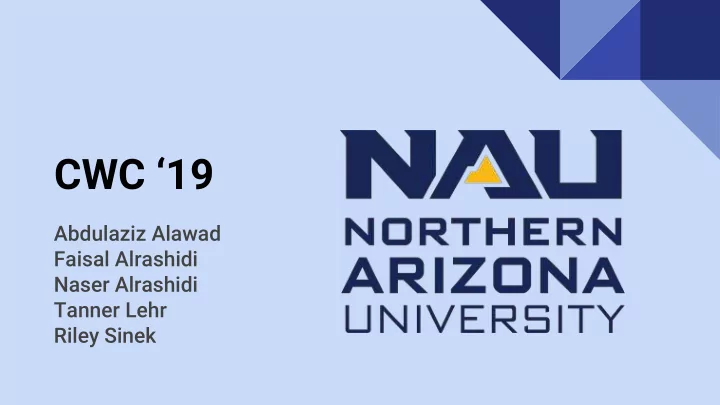

CWC ‘19 Abdulaziz Alawad Faisal Alrashidi Naser Alrashidi Tanner Lehr Riley Sinek
Project Description ● U.S. Department of Energy is the sponsor ● Collegiate Wind Competition ○ Competition held in Boulder, Co. May 13th-14th ○ Fifth team representing NAU at the Competition ○ Collaboration with Electrical Engineers Riley 1 1
Blade Design Background ● Use wind to produce lift Leads to torque around shaft, spinning the generator ○ ● Low Reynold’s Number operating environment ○ Must use a high camber airfoil to optimize lift Multiple airfoils implemented throughout the blade ● Riley 2
Blade Design Calculations ● Design to specified variables Tip-Speed Ratio = 5 ○ ○ Blade Number = 3 Ignore losses caused by blade and flow relationship ● ○ No tip loss ○ No Drag at operating attack angle Used MATLAB to calculate blade shape characteristics ● ○ Relative Wind Angle Chord length ○ ○ Twist angle Riley 3
Blade Design Results ● Operating Reynold’s numbers: Start-up: 3,443 ○ ○ Operating: 63,396 Q-Blade ● ○ Output of 30W predicted at rated wind speed ○ 25W expected ○ Start-up speed unpredictable in Q-Blade Riley 4
Blade CAD NACA 8510 on in-board ● ● NACA 9612 on out-board ● Future work will investigate the performance of Selig Series airfoils for future iterations Riley 5
Shaft Design Background ● Design consideration - Weight and size - Type of material - Safety and protection Naser 6
Shaft design Calculations ● Material Used for testing Carbon steel, alloy steel, Stainless steel ● Design torque = 3.8877N.m Bending moment = 0.4905N.m ● Three lengths were used ● L=10 cm , L=15 cm and L=20 cm Naser 7
Shaft design Results •Every material is analyzed using three different lengths and corresponding diameter are calculated using distortion energy theorem and maximum shear stress theory. Length of shaft(cm)Length of shaft(cm) Naser 8 Diameter of shaft(mm)
Shaft CAD ● Make Cad model using SolidWorks. Naser 9
Tower Design Assumption ● The wind velocity is constant through the tower Selected material that isotopic and incompressible ● Material should be linear, homogenous and elastic ● Abdulaziz 10
Tower background and analysis ● Von mises stress for the plane Normal strain ● Abdulaziz 11
Tower background and procedure ● Create base plate with 15 cm Bolt M10 *1.5 size ● Thickness of the plate 1.61 cm ● ● The length of the pipe defined as 61.91 cm include base plate and top plate ● Stainless steel defined in SolidWorks AISI-316 ○ Abdulaziz 12
Tower Cad Model ● Mesh Generation design Boundary conditions ● Von Mises stress result 5.314e+005 N/m 2 ● ● Deplacement analysis result 2.794e-003 mm ● Strain analysis result 2.331e-006 FOS analysis ● ○ 3.2e+002 and maximum was achieved by 1.00e+016. Abdulaziz 13
Yaw Design Background ● Yaw system is a crucial aspect in a wind turbine ● The rotor is yawed it is less efficient compared to the non-yawed rotor ● The overall efficiency of the wind turbines is mainly influenced by a variety of factors such as wind shear, wind turbulence and yaw Faisal 14
Yaw Governing Equations ● r=X+2c/3 = 3.3 mm ● Faisal 15
Brake Design Background / Calculations ● Provide sufficient force to rotor to stop the shaft from rotating Calculations done for Linear Actuator and Stepper Motor ● Clamping Force ● ○ D - diameter, P - operating pressure/force ● Brake Torque r e - equivalent radius, µ d - friction coefficient ○ Tanner 16
Brake Design Calculations / Results Assumptions: Brake rotor material is steel ● Brake pad material is rigid molded asbestos ● Friction Coef. Rotor Diameter (mm) Linear Actuator Force (N) Stepper Motor Force (N) 0.36 70 18 5.5 Results: Clamping Force (N) Braking Torque (Nm) Linear Actuator 153.94 3.33 Stepper Motor 47.04 1.02 Tanner 17
Brake Design CAD ● Linear actuator can apply more force Future: ● Testing will be done to compare linear actuator and stepper motors Tanner 18
Design / Customer Requirements ● Blades Cut-in speed must be between 2.5 and 5 m/s ○ ● Shaft ○ Withstand constant spinning from rotors Tower ● ○ Less than 15 cm in diameter Yaw ● ○ Must be able to yaw 180º/sec ● Brakes Must be able to stop at cut-out speed and for random tests ○ Tanner 19
Budget Table_ : Project budget sheet Available budget ● anticipated: $500.00 ○ ● Actual Expenses To Date: ○ $ 127.88 ● Current budget does not include electronics cost Faisal 20
Schedule ● We are on time! Faisal 21
Future Work ● EE team collaboration Begin building over Winter Break ● Begin testing in mid-February ● ● Upcoming assignments ○ Final Proposal Rewrite and Individual Post Mortem due 1/14 Website Check 1 due 1/28 ○ HR1 summary and Peer Eval 1 due 2/18 ○ Faisal 22
Questions? 23
Recommend
More recommend